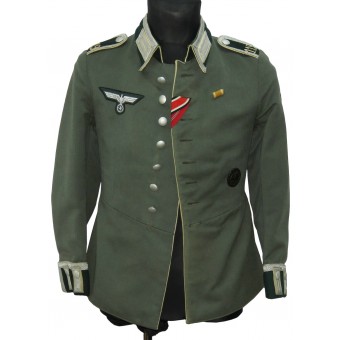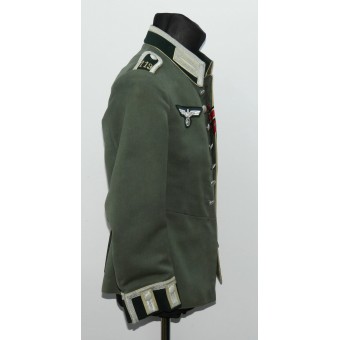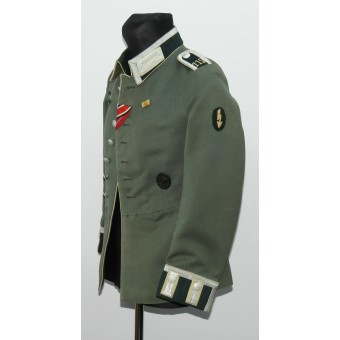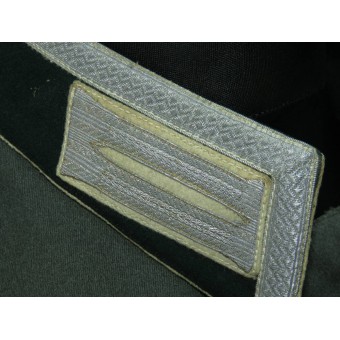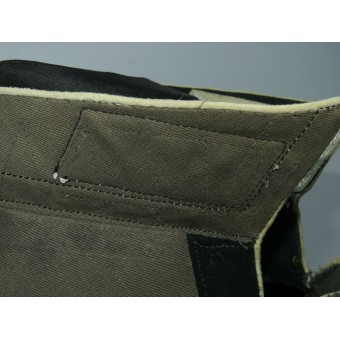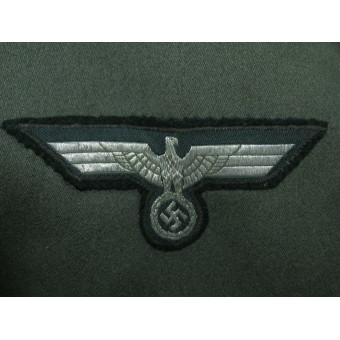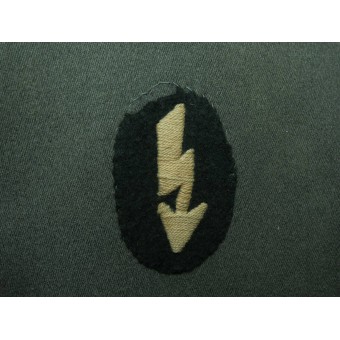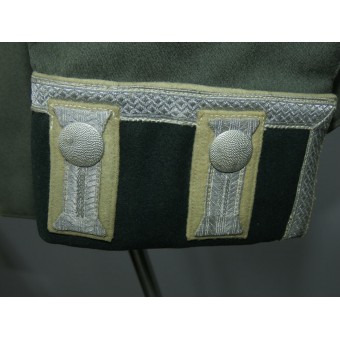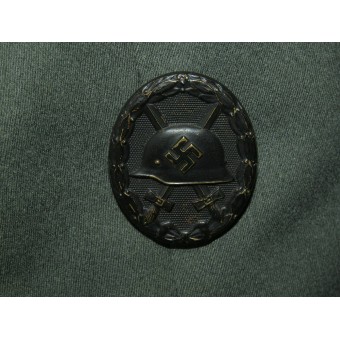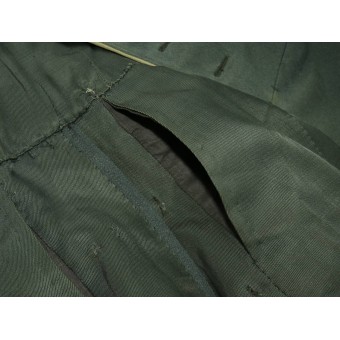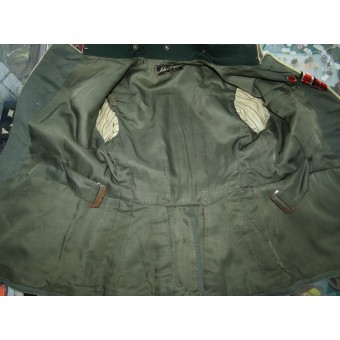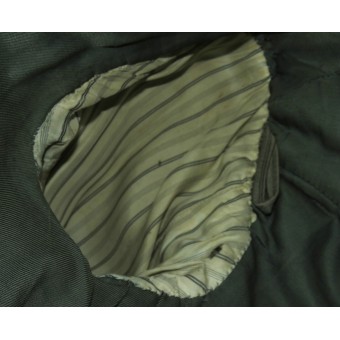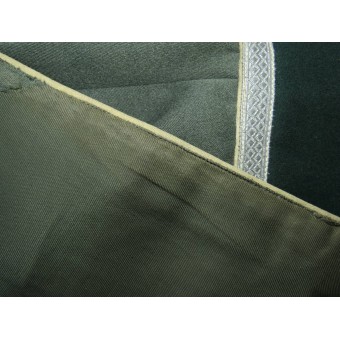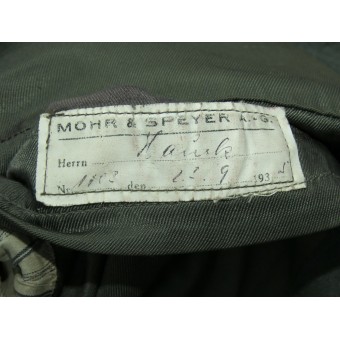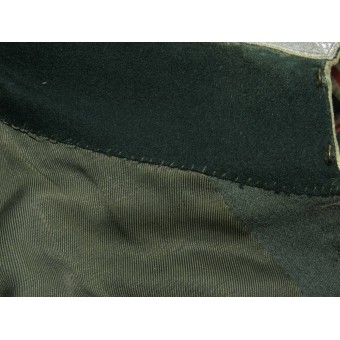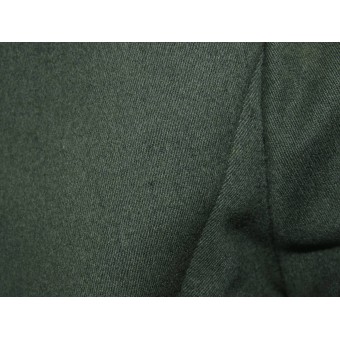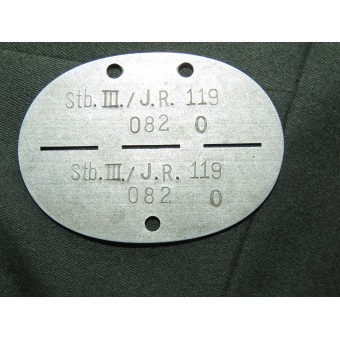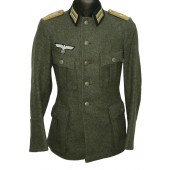Waffenrock of Unteroffizier of the 119th Inf Rgt with Erkennungsmarke
Waffenrock of Unteroffizier of the 119th Infantry Regiment, along with his ID tag. The owner of this uniform served in the headquarters of the third battalion of the 119th infantry regiment of the Wehrmacht, as evidenced by the encryption on the ID tag. The uniform is completed with the original to the tunic medal bar "West Wall" and wound badge, as well as the ribbon of the medal "frozen meat" and the ribbon of the iron cross. Most likely, the veteran attached the ribbons in the loop by himself after the war. Very small size, approximately 46-48. One missed button was found in the the back pocket of the lapel (we can sew it back by your wish ). The tunic has a "Mohr&Speyer A.G" tag sewn on, and a tag with the name of the customer and the date inside the pocket: "Haluk, September 23, 1935". Sewn-in shoulder straps with ciphers 119 embroidered with a chain stitch, as well as the emblem of signalmen in the infantry unit on the sleeve. Good condition with traces of use, without serious loss and vital activity of various insects. Hard to read units marking in rectangular.
The 119th Infantry Regiment participated in the second phase of the occupation of France as part of the 25th division, took part in the assault on Laon and Chemin-de-Dame, and then continued to pursue the defeated French army. The division moved to the Seine, which was forced at Romilly. The division then moved across the Loire towards Bourges. The division stayed here for several weeks as an occupying force and then returned to its garrisons. On November 15, 1940, the division was motorized and was subsequently designated the 25th Rifle Division (motorized). Since June 22, 1941, the regiment as part of the division participated in the Eastern Campaign and advanced from the Lublin region through the Bug to Lutsk and Kovno. At Tsvyahel-on-Sluch, the division broke through the Stalin line and moved towards Zhytomyr and Kyiv. After the closing of the Uman pocket, the division took part in the battle near Kiev. From September to November, the division advanced on Sumy, then Orel, and then advanced on Tula. In December 1941, the division had to retreat with fighting to the Susha and Oka. After retreating to the Susha-Oka position, the division had to conduct defensive and positional battles here until July 1942. In August 1942, the division took part in offensive battles through Bolkhov to Ulyanovo and then was used until the end of the year for positional war in the Kireykovo region north of Bolkhov. This trench warfare continued into 1943 when the division was reorganized into the 25th Grenadier Division. After the new formation, the division was used until the end of July 1943 for defence on the front arc north of Orel and in the Kireykovo / Annina area - on both sides of Bolkhov. Withdrawal from the Oryol Bulge followed: the defense of the Nugrian direction, reinforced by a tank detachment, until July 31, 1943 - a withdrawal through the Paramonovo position, then the Kosinka position in the Khotints area, approx. 45 km east of Karachev (west of Orel) - defense of the important road junction Khotynets until August 9 - securing on Karachev. March is about 250 km to the northwest of the Smolensk region in the Yartsevo-Dukhovshchina region. There was a merger of interchangeable marching companies into the division. This was followed by the defense of the position of the Tsesarevich River. Bryansk: Defense in the Maleevka area by the reinforced grenadier (mot) 119th grenadier regiment (Buffalo-Büffel fortified area) - from August 18, 1943 in the northeastern sector. Dukhovshchina, until mid-September. Then, until September 28, retreat to the position "Panther" (east), about 25 - 30 km west of Smolensk. Here the division defended from August 28 to October 29, 1943, in the areas of Verya and Rossassyonka. Then the defense of the position "Panther II" in the area northeast of Dubrovno, between the northern bank of the Dnieper and the highway, until June 1944. After expanding the section of the division to the south of the Dnieper, the successful defense of the position "Panther II". On the 4th and 5th military field road. Fighting west of Smolensk. After these battles, the division was updated and reorganized. In addition, new weapons were attributed to the division. From April 1944, the division withdrew to the area east of Minsk. There, the division was defeated and destroyed on July 6, 1944. Only the remnants managed to reach Grodno by mid-August. The combat group of Grimminger, formed from returning vacationers, scattered and recovering from minor wounds, was part of the 5th Panzer Division until the end of July, and then returned with other soldiers of the division, in the direction of Mielau through Suwalki, where all the remnants of the division gathered.
Waffenrock of Unteroffizier of the 119th Infantry Regiment, along with his ID tag. The owner of this uniform served in the headquarters of the third battalion of the 119th infantry regiment of the Wehrmacht, as evidenced by the encryption on the ID tag. The uniform is completed with the original to the tunic medal bar "West Wall" and wound badge, as well as the ribbon of the medal "frozen meat" and the ribbon of the iron cross. Most likely, the veteran attached the ribbons in the loop by himself after the war. Very small size, approximately 46-48. One missed button was found in the the back pocket of the lapel (we can sew it back by your wish ). The tunic has a "Mohr&Speyer A.G" tag sewn on, and a tag with the name of the customer and the date inside the pocket: "Haluk, September 23, 1935". Sewn-in shoulder straps with ciphers 119 embroidered with a chain stitch, as well as the emblem of signalmen in the infantry unit on the sleeve. Good condition with traces of use, without serious loss and vital activity of various insects. Hard to read units marking in rectangular.
The 119th Infantry Regiment participated in the second phase of the occupation of France as part of the 25th division, took part in the assault on Laon and Chemin-de-Dame, and then continued to pursue the defeated French army. The division moved to the Seine, which was forced at Romilly. The division then moved across the Loire towards Bourges. The division stayed here for several weeks as an occupying force and then returned to its garrisons. On November 15, 1940, the division was motorized and was subsequently designated the 25th Rifle Division (motorized). Since June 22, 1941, the regiment as part of the division participated in the Eastern Campaign and advanced from the Lublin region through the Bug to Lutsk and Kovno. At Tsvyahel-on-Sluch, the division broke through the Stalin line and moved towards Zhytomyr and Kyiv. After the closing of the Uman pocket, the division took part in the battle near Kiev. From September to November, the division advanced on Sumy, then Orel, and then advanced on Tula. In December 1941, the division had to retreat with fighting to the Susha and Oka. After retreating to the Susha-Oka position, the division had to conduct defensive and positional battles here until July 1942. In August 1942, the division took part in offensive battles through Bolkhov to Ulyanovo and then was used until the end of the year for positional war in the Kireykovo region north of Bolkhov. This trench warfare continued into 1943 when the division was reorganized into the 25th Grenadier Division. After the new formation, the division was used until the end of July 1943 for defence on the front arc north of Orel and in the Kireykovo / Annina area - on both sides of Bolkhov. Withdrawal from the Oryol Bulge followed: the defense of the Nugrian direction, reinforced by a tank detachment, until July 31, 1943 - a withdrawal through the Paramonovo position, then the Kosinka position in the Khotints area, approx. 45 km east of Karachev (west of Orel) - defense of the important road junction Khotynets until August 9 - securing on Karachev. March is about 250 km to the northwest of the Smolensk region in the Yartsevo-Dukhovshchina region. There was a merger of interchangeable marching companies into the division. This was followed by the defense of the position of the Tsesarevich River. Bryansk: Defense in the Maleevka area by the reinforced grenadier (mot) 119th grenadier regiment (Buffalo-Büffel fortified area) - from August 18, 1943 in the northeastern sector. Dukhovshchina, until mid-September. Then, until September 28, retreat to the position "Panther" (east), about 25 - 30 km west of Smolensk. Here the division defended from August 28 to October 29, 1943, in the areas of Verya and Rossassyonka. Then the defense of the position "Panther II" in the area northeast of Dubrovno, between the northern bank of the Dnieper and the highway, until June 1944. After expanding the section of the division to the south of the Dnieper, the successful defense of the position "Panther II". On the 4th and 5th military field road. Fighting west of Smolensk. After these battles, the division was updated and reorganized. In addition, new weapons were attributed to the division. From April 1944, the division withdrew to the area east of Minsk. There, the division was defeated and destroyed on July 6, 1944. Only the remnants managed to reach Grodno by mid-August. The combat group of Grimminger, formed from returning vacationers, scattered and recovering from minor wounds, was part of the 5th Panzer Division until the end of July, and then returned with other soldiers of the division, in the direction of Mielau through Suwalki, where all the remnants of the division gathered.


